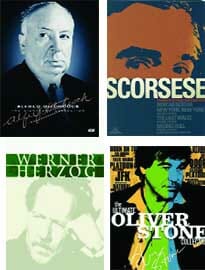
From film school classrooms to the Hollywood corridors of power, the Cult of the Director holds sway. Even above many A-list stars, the “auteur filmmaker” is king, and their names are spoken in hushed reverence and baited breath. Unfortunately, the phrase “a film by” which typically precedes a director’s name in the credits essentially negates the contributions of writers, producers, editors and the other countless individuals who help make a movie. So while this may not be a fair assessment, when one considers the overall body of a director’s work, their real contribution and style comes forward. In the case of these new DVD box sets, the distinct visions of four very different masters serves as a testament to just what a director contributes to the art of cinema.
It’s widely agreed that Alfred Hitchcock is a towering figure in film. Indeed, the term “Hitchcockian” is an essential adjective in the film lexicon (a distinction that refers to his particular style, since he did not write his films). The nine movies in The Hitchcock Signature Collection are culled from his output for RKO and Warner Brothers in the ’40s and ’50s. While not always his finest work (those interested should seek out the now out-of-print Criterion Collection box), these films are never less than engaging (as with the workmanlike espionage thriller Foreign Correspondent) and sometimes quite surprising (as with the unusual screwball comedy Mr. & Mrs. Smith).
While Hitchcock can’t be credited with the sly structure of a film like Stage Fright (1950)—which opens with a couple fleeing a murder and flashes back to establish an ultimately deceptive backstory—his mastery of visual storytelling is evident from the first frame. Indeed, a shot-by-shot consideration of the thrilling carnival sequence in Strangers On A Train (1951) should quickly silence all skeptics. Aside from his technical prowess, the themes that run through the films inform the Hitchcockian approach, returning to crises of identity (The Wrong Man, North By Northwest) and the imagery of the theater (Stage Fright and the final scene in I Confess).
Probably the most lauded living director is Martin Scorcese, so it’s no surprise that he would be the focus of two new DVD sets. While both collections feature interesting career highlights, the films in the Martin Scorcese Collection probably best represent the full range of his gifts. His genius for gritty underworld studies can be found in Mean Streets (1973) and Goodfellas (1990). Scorcese also proved himself equally adept at other genres, as with the dark comedy of After Hours (1985) and the sensitive character study of Alice Doesn’t Live Here Anymore (1974). All the films share his gift for bravura filmmaking, which one can see developing in the bold sex sequence in his first feature, Who’s That Knocking At My Door (1968), and coming to full force in the brilliant extended tracking shot in Goodfellas.
In the minds of many, his creative partnership with Robert De Niro epitomized the Scorcese aesthetic, and two of their finest collaborations are in The Martin Scorcese Film Collection. While Raging Bull (1980) is widely regarded as their triumph, the underappreciated musical “experiment” New York, New York (1977) features one of De Niro’s most kinetic and compelling performances. Never one to withhold his thoughts on film, Scorcese offers a commentary track on most of the discs, and many boast engaging featurettes.
Though he has never achieved the commercial success of Hitchcock or Scorsese (at least in the United States), Werner Herzog is no less of an influential director. The films on this set represent some of his boldest work. From the impressionistic documentary of Fata Morgana (1969) to the dreamy Heart Of Glass (1976) (which was supposedly shot with a cast under hypnotic suggestion), these films showcase Herzog’s daring spirit. Most affecting are The Enigma Of Kaspar Hauser (1974) and Stroszek (1976), which both explore the struggle of the outsider in society and feature “outsider” actor Bruno S. in truly haunting performances. Herzog himself comes off as an outsider in these films, at once formal and experimental, sentimental and bitterly pessimistic.
Also considered a renegade (at least by Hollywood standards), Oliver Stone is that rare beast, the mainstream maverick. The huge 9-disc Oliver Stone Collection covers his work from breakout films Platoon and Salvador (both 1986) to brazen studies of power and corruption like JFK (1991) and Nixon (1995). While his drive to provoke has sometimes resulted in uneven output (the self-righteous moralizing of 1987’s Wall Street and the over-the-top barrage of ’94’s Natural Born Killers), Stone set himself apart with a determination to question authority, be it in the government or the media. The documentary work represented in the set continues this theme, examining the public perception of power firsthand in Looking For Fidel, and through the filter of history in On The Set Of Alexander.
Ultimately, a consideration of the work of these directors itself is a study in power and leadership. As the audience, we are de facto followers, hoping each film takes us to a place of discovery. Thankfully, these directors clearly understood their power: a power to create and illuminate.